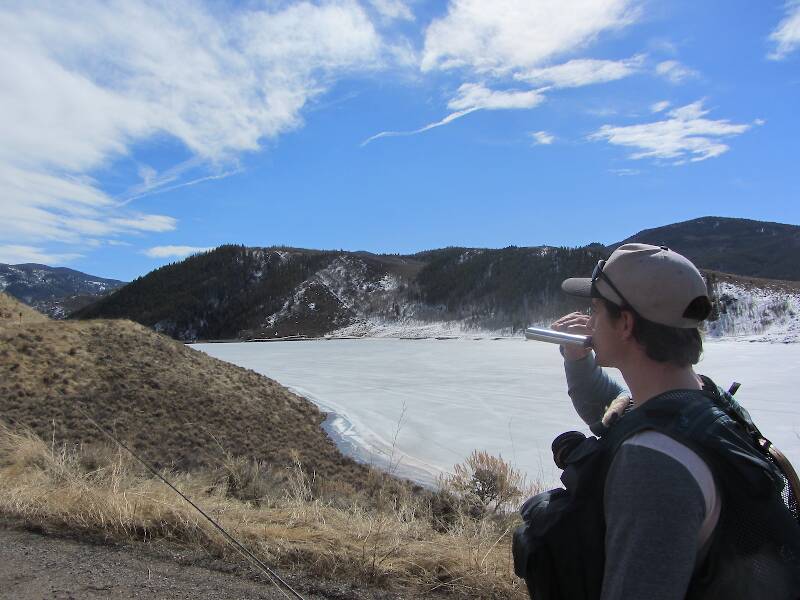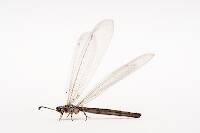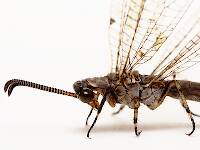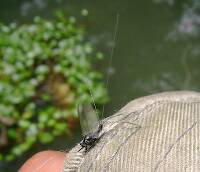
Hex Mayflies
Hexagenia limbata
The famous nocturnal Hex hatch of the Midwest (and a few other lucky locations) stirs to the surface mythically large brown trout that only touch streamers for the rest of the year.
Featured on the forum
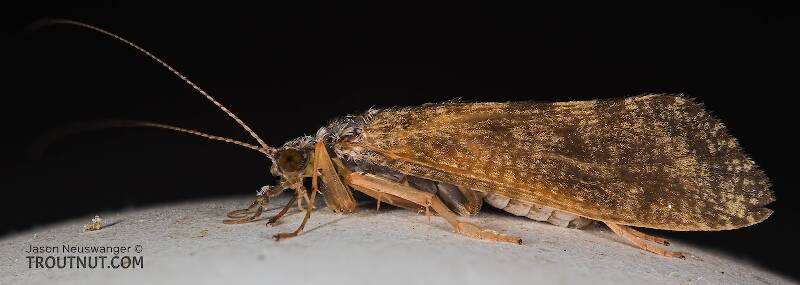

Troutnut is a project started in 2003 by salmonid ecologist Jason "Troutnut" Neuswanger to help anglers and
fly tyers unabashedly embrace the entomological side of the sport. Learn more about Troutnut or
support the project for an enhanced experience here.
Troutnut on Jul 12, 2006July 12th, 2006, 1:10 pm EDT
I really like this stuff!
It's one of those million tri-lobal yarns on the market, like Antron and Z-lon and Sparkle Yarn and who knows what else. This one is especially stiff and it seems to make much better spinner wings than the others.
It's one of those million tri-lobal yarns on the market, like Antron and Z-lon and Sparkle Yarn and who knows what else. This one is especially stiff and it seems to make much better spinner wings than the others.
Jason Neuswanger, Ph.D.
Troutnut and salmonid ecologist
Troutnut and salmonid ecologist
West on Aug 18, 2006August 18th, 2006, 3:03 pm EDT
Sounds like good stuff. Standard poly yarn is really too pliable and fuzzy for small patterns like tricos. It's fine for most situations, but can get a little hard to work with on the small, intricate patterns.
West
http://pleasantly-obsessed.blogspot.com/
http://pleasantly-obsessed.blogspot.com/
Troutnut on Aug 18, 2006August 18th, 2006, 3:09 pm EDT
Interesting... I have more trouble with the soft stuff on large patterns! It seems the longer the wing, the more easily it gets too floppy with that stuff. By "large" I'm talking size 12-16. My Hi-Vis patterns are keeping their shape pretty well after several fish.
I've tied a few size 4ish Hex spinners with this stuff too, and they look really cool. I use the "triple wing" style to create a realistic profile, but expand it to six or seven "wings" for the Hexes.
I've tied a few size 4ish Hex spinners with this stuff too, and they look really cool. I use the "triple wing" style to create a realistic profile, but expand it to six or seven "wings" for the Hexes.
Jason Neuswanger, Ph.D.
Troutnut and salmonid ecologist
Troutnut and salmonid ecologist
West on Aug 18, 2006August 18th, 2006, 3:34 pm EDT
I would like to see those Hex spinners! I know that when you're fishing the Hex hatch, it's very nice to have a pattern that can last a few fish. Even with the large hooks it's never fun to spend the hottest time of the hatch fumbling around with a new fly to tie on. The poly yarn does sort of get bent out of shape after a fish or two.
West
http://pleasantly-obsessed.blogspot.com/
http://pleasantly-obsessed.blogspot.com/
GONZO on Sep 23, 2006September 23rd, 2006, 5:34 pm EDT
I, too, am a big fan of Hi-Vis--particularly for larger flies. I'm far less enthusiastic about the packaging, however. The real art to using it is getting through a bag without ending up with a mass of tangled fibers before it's gone!
Despite this, I think its great virtue is its ability to maintain its shape and bulk (or width, in the case of spinner wings) through repeated use by me and the fish. And as a substitute for deer- or elk-hair in Elk-Hair Caddis or Compara-dun style flies it is more visible, more durable, and, when treated, even more buoyant (especially in the long run and after multiple fish).
Oddly, this buoyancy is not so much due to the specific gravity of the fiber (unlike poly, which is lighter than water but tends to wick). I believe it is some sort of acrylic fiber and achieves its flotation by maintaining surface area and air space between the fibers.
The "triple-wing"--or in Jason's case, "sextuple-wing"--is a great tying style. Most of the time, however, I just tie in an appropriately sized single clump; spread the fibers widely (for really large spinners like Hex or Coffin Flies, I squeeze the wing-base flat with hemos or pliers); apply a little (thick) Zap-A-Gap to the wing-base with a needle; then shape with scissors. I find they maintain their shape just fine, and the fewer clumps I pull out of the bag, the happier I am! :)
Despite this, I think its great virtue is its ability to maintain its shape and bulk (or width, in the case of spinner wings) through repeated use by me and the fish. And as a substitute for deer- or elk-hair in Elk-Hair Caddis or Compara-dun style flies it is more visible, more durable, and, when treated, even more buoyant (especially in the long run and after multiple fish).
Oddly, this buoyancy is not so much due to the specific gravity of the fiber (unlike poly, which is lighter than water but tends to wick). I believe it is some sort of acrylic fiber and achieves its flotation by maintaining surface area and air space between the fibers.
The "triple-wing"--or in Jason's case, "sextuple-wing"--is a great tying style. Most of the time, however, I just tie in an appropriately sized single clump; spread the fibers widely (for really large spinners like Hex or Coffin Flies, I squeeze the wing-base flat with hemos or pliers); apply a little (thick) Zap-A-Gap to the wing-base with a needle; then shape with scissors. I find they maintain their shape just fine, and the fewer clumps I pull out of the bag, the happier I am! :)
Martinlf on Nov 5, 2006November 5th, 2006, 5:07 am EST
Although I've mainly gone to grizzly hackle and CDC wings for Tricos, and am contemplating snowshoe due to a recommendation from an angler who fishes the Little Lehigh (a tough Trico stream near Allnetown, PA), I still use Hi-vis for some Tricos. I can't remember who suggested this, or if I do it exactly as his or her article suggested, but a very visible Trico can be tied from Hi-viz in which a bunch of wing material is laid on the the top of the shank, bound in the center, and then thread dams are erected in front to create a mini comparadun wing and the back can be done the same way or tied into two wings with figure eights in typical poly wing spinner style. A bit of Krystal Flash can be tied in also, though this is tricky. I think I have more complete directions in a file and will post below if anyone is interested. I fished these spinners all one season, and loved the way they showed up on the water. Use a sparse bunch and spread the fibers out.
Found the Trico directions, which come from an email I sent another angler. Let me know what you think,
Perhaps Gonzo can tell us his source for colored hi-viz for mayfly legs in the melted wing patterns from his book. I finally called the manufacturer and he sent me what I wanted, but he said he doesn't typically do this, so I don't know if it will work all the time. He was really very nice, even sent some extra materials, so it's not like he was cranky or anything. But I called because I had trouble finding all the colors I wanted, and straight from the manufacturer was able to get some neat ones, such as sulphur, for dorthea and invaria (or is it rotunda now, I forget) legs. Are there other good sources for this? oh yes, and for dark poly yarn for wings??
Found the Trico directions, which come from an email I sent another angler. Let me know what you think,
Perhaps Gonzo can tell us his source for colored hi-viz for mayfly legs in the melted wing patterns from his book. I finally called the manufacturer and he sent me what I wanted, but he said he doesn't typically do this, so I don't know if it will work all the time. He was really very nice, even sent some extra materials, so it's not like he was cranky or anything. But I called because I had trouble finding all the colors I wanted, and straight from the manufacturer was able to get some neat ones, such as sulphur, for dorthea and invaria (or is it rotunda now, I forget) legs. Are there other good sources for this? oh yes, and for dark poly yarn for wings??
"He spread them a yard and a half. 'And every one that got away is this big.'"
--Fred Chappell
--Fred Chappell
Martinlf on Nov 5, 2006November 5th, 2006, 5:11 am EST
I have two trico patterns that have worked very well on the Tully [Tulpehocken Creek, near Reading PA] this summer [probably 2003; these are old directions], and the first one is derived from a hint in the Trico article in a recent summer issue of Fly Fisherman. One of the contributors mentioned a double wing pattern. I start the fly on a Varivas midge hook or Tiemco 2488 (a 22 ties a 26 trico, a 24 ties a 28, etc) in a traditional manner: I tie the tails with micro fibbets and the abdomen with thread--black or white 8/0 unithread. [I've quit using tails on Tricos, from a hint on the Little Lehigh Fly Shop website. It has a deadly Trico pattern--and very hard to see on the water, I'd add] I had a devil of a time figuring out the double wing idea, but learned to tie a small sparse bunch of hi-vis on the top of the hook, parallel to the shank, with one wrap over the middle of the bunch, then one wrap just in front of (i.e. under) the high vis (like wraps to stand up a comparadun wing) and then one in back (again, under the high vis at the base), then split the back tips (the ones pointing toward the tail) and figure eight into a standard spinner wing. The front bunch is then stood up and splayed comparadun style. I take some black superfine and build a thorax behind and in front of the double wing, sometimes with a wrap or two of dubbing in between the two wings. I then tie off and trim them by holding all the high vis fibers straight up and trimming a mayfly shape to the wing--a bit taller in front, shorter in back. Next I pull fibers down to get some of them them perpindicular to the shank and parallel to the water's surface. the final fly has kind of a rough hemisphere of high vis above the water's surface when fished, but just a few fibers on the water's surface. It's very visible, and fools fish that won't take a traditional spinner. I sometimes tie in two strands of crystal flash, one on either side of the shank, with the same one wrap over, one wrap in front then one behind, to make a base for the high vis, the high vis is then tied as above, but over the crystal flash, which stays (to some degree, most of the time, at least, on the bottom of the wing). It's a pain, and requires a magnifier, but it gives the fish something new to ponder. My newest tie, and one that has taken some very picky fish, is similar, but I use a bunch of white CDC with a very few thin strands of pearl blue angel hair or ice dub mixed in. I can't remember if I try to figure eight the back bunch or if I just stand it up CDC style.
"He spread them a yard and a half. 'And every one that got away is this big.'"
--Fred Chappell
--Fred Chappell
GONZO on Nov 5, 2006November 5th, 2006, 12:54 pm EST
Hi Louis,
I love Hi-vis (except for that packaging thing), but I'd have to say that I don't particularly like it for very small flies (like tricos). It's a bit too stiff and wiry--the very qualities I like for maintaining wing width on larger flies. I usually substitute Z-Lon or Antron for the tiny stuff. For what it's worth, the deadliest trico dries I've fished (especially when things get tough in the latter part of the hatching season) had one thing in common--they were all inverted ties.
(I was about to add my opinion of CDC, Louie, but we can handle that in a PM--I don't want to provoke the ire of the Duck Butt Society!) :)
PS--Unless you are fortunate enough to stumble upon a shop that stocks more than a few colors of Hi-vis or poly, the solution is dye or marker color. Marker is quick and easy, but slightly less permanent (just rejuvenate the color when it fades). Dyeing is more of a pain, but it's the way to go when a frequently needed color is unavailable.
I love Hi-vis (except for that packaging thing), but I'd have to say that I don't particularly like it for very small flies (like tricos). It's a bit too stiff and wiry--the very qualities I like for maintaining wing width on larger flies. I usually substitute Z-Lon or Antron for the tiny stuff. For what it's worth, the deadliest trico dries I've fished (especially when things get tough in the latter part of the hatching season) had one thing in common--they were all inverted ties.
(I was about to add my opinion of CDC, Louie, but we can handle that in a PM--I don't want to provoke the ire of the Duck Butt Society!) :)
PS--Unless you are fortunate enough to stumble upon a shop that stocks more than a few colors of Hi-vis or poly, the solution is dye or marker color. Marker is quick and easy, but slightly less permanent (just rejuvenate the color when it fades). Dyeing is more of a pain, but it's the way to go when a frequently needed color is unavailable.
Martinlf on Nov 6, 2006November 6th, 2006, 11:21 am EST
Thanks for the tips, Gonzo. I hadn't thought of the Hi Viz stiffness as a detriment in small flies, but I will try antron instead. I like upside down flies, and will give your Trico pattern a go next summer for sure. Remind me to show you my tiny upside down baetis duns sometime, and for Trico's take a look at the Little Lehigh Fly Shop "Al's Trico."
http://www.littlelehighflyshop.com/generic3.html
Whether or not one agrees with Rod's tying philosophy, I do believe this fly may work at times when nothing else will. The BWO emerger here is also good at times, with it's short CDC wing, much like the RS2 described in the fav fly thread on this forum. It has seemed, in my limited experience, that there are times CDC will work when other flies fail, but my lack of finess may be responsible for that conclusion. More and more the scientist in me wishes there were some nice double blind studies on such controversies. I certainly defer to your judgment in general, and look forward to discussing the benefits and demerits of duck butt plumage at some point. I'll have to confess, though, that so far the deadliest fly I've found for those old picky Tully trout was an upside down CDC caddis. It's also worked on some other fish that weren't interested in the flies I (and others) were slinging previously. But I'm keeping an open mind. OK, I have to get those papers graded. You Cul de Canard fans, weigh in and let the fireworks begin.
http://www.littlelehighflyshop.com/generic3.html
Whether or not one agrees with Rod's tying philosophy, I do believe this fly may work at times when nothing else will. The BWO emerger here is also good at times, with it's short CDC wing, much like the RS2 described in the fav fly thread on this forum. It has seemed, in my limited experience, that there are times CDC will work when other flies fail, but my lack of finess may be responsible for that conclusion. More and more the scientist in me wishes there were some nice double blind studies on such controversies. I certainly defer to your judgment in general, and look forward to discussing the benefits and demerits of duck butt plumage at some point. I'll have to confess, though, that so far the deadliest fly I've found for those old picky Tully trout was an upside down CDC caddis. It's also worked on some other fish that weren't interested in the flies I (and others) were slinging previously. But I'm keeping an open mind. OK, I have to get those papers graded. You Cul de Canard fans, weigh in and let the fireworks begin.
"He spread them a yard and a half. 'And every one that got away is this big.'"
--Fred Chappell
--Fred Chappell
GONZO on Nov 6, 2006November 6th, 2006, 3:31 pm EST
OK, Louie, I know I sparked the fire, but now you're fanning the flames! :) Just kidding, I take no issue with anything you said.
Really, my problem with CDC has less to do with its effectiveness in fooling fish (which it does very well) than with its fishability and versatility. When the buzz about CDC started many years ago, I purchased several packages and devised several promising prototypes. I was pretty excited about them at first, but the more I fished them the more I was disappointed by CDC's shortcomings.
My biggest disappointment was that CDC flies often end up being one- or two-fish flies. I know that's not a big deal for some, but when things are hot and heavy during a hatch, the last thing I want to do is change flies after every fish or two. And fussing around to unslime things and get the fly floating again is not much better.
My other problem is more of a design issue. CDC just isn't good for imitating everything, and when I want to combine it with a material that needs to be dressed with floatant, it becomes problematic. I've heard some say that the answer is "preen oil," but the oil from the duck's preen gland has little to do with CDC's floating ability. (From a dry-fly standpoint, the floatation comes from the tiny interlocking hairlike fibers that trap air and hold out water. Oiling them up may make them waterproof, but it doesn't make them float better.)
Perhaps one of the dry powder floatants would work better with these mixed material flies, but then who needs expensive feathers from a duck's butt? Ordinary and cheap marabou will work just as well. In fact, during my early experiments with the stuff, I found that even undressed marabou worked nearly as well. I faced the same problems with either feather and the only advantage of CDC was that maybe I'd get one extra fish before it was slimed all to hell.
Now don't get me wrong, as I've said before, I hate to argue against success. If these things don't bother you, and you have confidence in a particular fly, I'd encourage you to keep tying and using it. And you must know that I have no problem devoting a lot of time to the design and construction of flies. But when I'm on the stream, I want those flies to be durable and to perform without a lot of constant fussing. For me, CDC just isn't up to the task. The original packets I purchased are still sitting (some unopened) among my tying materials.
And just to mention something from your earlier post on another thread--Louie, my friend, there is absolutely no reason to apologize for using a beadhead fly. If I'm not mistaken, Walt's Worm is tied "in-the-round," and that's a simple and sensible beadhead design. My main problem is with "sided" beadheads that end up showing the side that is supposed to fool the trout to the stream bottom. You can't just stick a beadhead on any standard pattern and expect it to drift properly. (My other issues are with imitation and overexposure, but those are specific "pressured water" problems.)
For me, fly fishing and fly tying are very personalized things. I really don't expect everyone to share my opinions or approaches, and I don't particularly want them to. I don't think I've ever tried to convince anyone that a fly that they trusted was no good. If you enjoy what you're doing and treat the fish and your fellow fishers with respect, you'll never have a problem with me! :) Flame on!
Really, my problem with CDC has less to do with its effectiveness in fooling fish (which it does very well) than with its fishability and versatility. When the buzz about CDC started many years ago, I purchased several packages and devised several promising prototypes. I was pretty excited about them at first, but the more I fished them the more I was disappointed by CDC's shortcomings.
My biggest disappointment was that CDC flies often end up being one- or two-fish flies. I know that's not a big deal for some, but when things are hot and heavy during a hatch, the last thing I want to do is change flies after every fish or two. And fussing around to unslime things and get the fly floating again is not much better.
My other problem is more of a design issue. CDC just isn't good for imitating everything, and when I want to combine it with a material that needs to be dressed with floatant, it becomes problematic. I've heard some say that the answer is "preen oil," but the oil from the duck's preen gland has little to do with CDC's floating ability. (From a dry-fly standpoint, the floatation comes from the tiny interlocking hairlike fibers that trap air and hold out water. Oiling them up may make them waterproof, but it doesn't make them float better.)
Perhaps one of the dry powder floatants would work better with these mixed material flies, but then who needs expensive feathers from a duck's butt? Ordinary and cheap marabou will work just as well. In fact, during my early experiments with the stuff, I found that even undressed marabou worked nearly as well. I faced the same problems with either feather and the only advantage of CDC was that maybe I'd get one extra fish before it was slimed all to hell.
Now don't get me wrong, as I've said before, I hate to argue against success. If these things don't bother you, and you have confidence in a particular fly, I'd encourage you to keep tying and using it. And you must know that I have no problem devoting a lot of time to the design and construction of flies. But when I'm on the stream, I want those flies to be durable and to perform without a lot of constant fussing. For me, CDC just isn't up to the task. The original packets I purchased are still sitting (some unopened) among my tying materials.
And just to mention something from your earlier post on another thread--Louie, my friend, there is absolutely no reason to apologize for using a beadhead fly. If I'm not mistaken, Walt's Worm is tied "in-the-round," and that's a simple and sensible beadhead design. My main problem is with "sided" beadheads that end up showing the side that is supposed to fool the trout to the stream bottom. You can't just stick a beadhead on any standard pattern and expect it to drift properly. (My other issues are with imitation and overexposure, but those are specific "pressured water" problems.)
For me, fly fishing and fly tying are very personalized things. I really don't expect everyone to share my opinions or approaches, and I don't particularly want them to. I don't think I've ever tried to convince anyone that a fly that they trusted was no good. If you enjoy what you're doing and treat the fish and your fellow fishers with respect, you'll never have a problem with me! :) Flame on!
Martinlf on Nov 7, 2006November 7th, 2006, 1:20 am EST
Hey, Gonzo, I appreciate your answer, and I was partly joking about the beadhead, though I do respect your opinion above that of many other fishing authors; your analyses just make sense (at least in most cases--OK kidding again :) One of Rene Harrop's guides, who showed me perhaps the most effective emerger patterns I've seen (a thorax emerger with a dark biot abdomen and thorax the color of the dun--PMD's that day on the Henry's Fork), doesn't care for CDC. Imagine that. But Mike Heck who guides on Falling Spring got me to use Frog's Fanny on CDC, and it works wonders. I have some of the Preen Oil Flotant (Harrop makes and sells it) and it works fairly well too, but the Fanny dries and restores the fly. By the way, I caught at least 5 fish on Spring Creek one day on one upside down baetis, (not the ones I mentioned earler, which have a parachute under the hook, but a simple upside down CDC winged fly with a shuck, that at times fishes very well, at times not, but that's another story) before having to change it. And this was in a steady rain that had me, my shivering fingers, and my fly drying patch damp to soggy. So. since the other aficinados of duck hinney feathers aren't speaking up, I'm rushing to the CDC defense. When it works, I believe it's magic on tough fish. That said, I'm preferring snowshoe these days when it works better, such as in some mayfly emergers. It floats almost forever. And I sometimes put a bit of it under a CDC caddis wing, as per a pattern I read about on a Delaware River flyshop site. But Snowshoe doesn't flow streight the way CDC does, and it has a tendency to ball up in time. OOps, out of time, and gotta run. Catch you later.
"He spread them a yard and a half. 'And every one that got away is this big.'"
--Fred Chappell
--Fred Chappell
GONZO on Nov 7, 2006November 7th, 2006, 4:24 am EST
I think it says something really nice about Rene Harrop that he employs a guide who doesn't like his pet fly-tying material. (Or perhaps he doesn't know?) The combination of snowshoe and CDC is a very compatible marriage. I'm sure that a number of beguiling patterns can be devised that take advantage of this union.
Five fish without changing the fly is very good performance for a CDC pattern, and better than I have achieved. (Maybe I'm just catching slimier trout. :) ) Allow me to share an incident that really sold me on the performance of one of my favorite dries:
About 20 years ago I started substituting Z-Lon for the wing on Compara-duns. This was mostly to help my one-armed fishing partner with his tying--it was one of the first patterns he was able to master without too much frustration. We first fished the flies during a Hendrikson hatch on the Tobyhanna. We were each able to land 40+ trout during that hatch without changing the fly! From a fishing standpoint, this was no great feat--the fish were recently stocked and the natural "chum" made them like the proverbial fish-in-a-barrel. (I wanted to put my friend over some easy fish to boost his confidence--it was early in his fly-fishing career, and he has long since graduated to pursuing much more challenging targets.)
The perfomance of those two flies was remarkable. By the time we finished, the bodies were tattered and torn (I've since taken to ribbing the body for greater durability), but it didn't hinder their effectiveness. It was a breakthrough day for my friend.
Five fish without changing the fly is very good performance for a CDC pattern, and better than I have achieved. (Maybe I'm just catching slimier trout. :) ) Allow me to share an incident that really sold me on the performance of one of my favorite dries:
About 20 years ago I started substituting Z-Lon for the wing on Compara-duns. This was mostly to help my one-armed fishing partner with his tying--it was one of the first patterns he was able to master without too much frustration. We first fished the flies during a Hendrikson hatch on the Tobyhanna. We were each able to land 40+ trout during that hatch without changing the fly! From a fishing standpoint, this was no great feat--the fish were recently stocked and the natural "chum" made them like the proverbial fish-in-a-barrel. (I wanted to put my friend over some easy fish to boost his confidence--it was early in his fly-fishing career, and he has long since graduated to pursuing much more challenging targets.)
The perfomance of those two flies was remarkable. By the time we finished, the bodies were tattered and torn (I've since taken to ribbing the body for greater durability), but it didn't hinder their effectiveness. It was a breakthrough day for my friend.
Martinlf on Nov 7, 2006November 7th, 2006, 4:53 am EST
Gonzo, You've already convinced me about using Zelon on comparaduns. Several years ago Flick Ford, who fishes the Delaware and is well known at the Delaware River Club, told me he hates to use deer hair and had much better tying and fishing success with Zelon comparaduns. I was unsure about this, but your book confirmed that idea for me. Below is some information on Flick I cut and pasted from the net; you may know his work:
Flick Ford, well known painter and longtime friend of the Delaware River Club, recently had 77 of his fish paintings published in a coffee table book titled “FISH”. Covering fresh and saltwater gamefish, Flick’s paintings include a Delaware River rainbow trout and smallmouth bass, and an Andros Island bonefish.
Flick Ford, well known painter and longtime friend of the Delaware River Club, recently had 77 of his fish paintings published in a coffee table book titled “FISH”. Covering fresh and saltwater gamefish, Flick’s paintings include a Delaware River rainbow trout and smallmouth bass, and an Andros Island bonefish.
"He spread them a yard and a half. 'And every one that got away is this big.'"
--Fred Chappell
--Fred Chappell
Troutnut on Nov 11, 2006November 11th, 2006, 6:38 am EST
Not to stray from the excellent tying discussion, but since the topic of Lloyd's one-armed fishing partner came up, I just wanted to mention what an inspiring story of innovation that was in his book!
It really made me think about how many different ways there are to do some of the same things at the tying bench. If I had to start tying with one hand, I would be completely lost. That's a really amazing skill if you think about it.
Lloyd you should invite your friend to this forum! :)
It really made me think about how many different ways there are to do some of the same things at the tying bench. If I had to start tying with one hand, I would be completely lost. That's a really amazing skill if you think about it.
Lloyd you should invite your friend to this forum! :)
Jason Neuswanger, Ph.D.
Troutnut and salmonid ecologist
Troutnut and salmonid ecologist
GONZO on Nov 11, 2006November 11th, 2006, 12:15 pm EST
Since he became aware that I was posting here, I'm sure he looks in from time to time as an unregistered viewer. (Probably just to see what I'm saying about him!) If he does decide to register, I'm pretty sure what his avatar will be--Bandit. (That's the name I paint on the butt of every fly rod he makes!)
Quick Reply
Related Discussions
Topic
Replies
Last Reply
6
Nov 4, 2011
by Dinerobyn
by Dinerobyn
1
Sep 21, 2008
by GONZO
by GONZO
4
Jan 19, 2015
by Kschaefer3
by Kschaefer3



